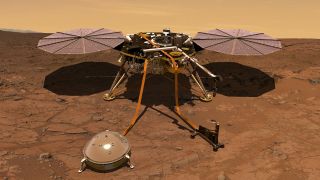Scientists peer inside Mars to measure layers of Red Planet

Marsquakes recorded by NASA's InSight mission offer the first direct evidence of key boundaries in the Martian interior, which could help planetary scientists understand how rocky planets are formed, a new study suggests.
The spacecraft landed at Elysium Planitia in November 2018 on a quest to probe the poorly understood interior of Mars. The thickness of the Red Planet crust and the depth of its core, for example, had only been estimated with models before. InSight allows researchers to check their models for the first time.
InSight probes the Martian interior with its seismometer, which rests directly on the ground, overcoming a problem a similar instrument encountered on Viking 2 in the 1970s; that seismometer was high on the spacecraft and swayed in the wind. (Viking 1's seismometer failed before it could take measurements, according to NASA.)
Related: InSight Mars lander snaps dusty selfie on Red Planet (photo)
InSight has measured more than 170 trembles between February and September 2019, marking the first definitive seismic measurements taken on Mars. InSight remains active today and more measurements will be integrated in future studies.
The InSight seismometer measures vibrations from seismic waves, which emanate from the source of disturbances such as marsquakes or meteor strikes. The shape and strength of the waves also allow scientists to estimate the composition of the Red Planet's interior, especially because these waves change slightly as they move through different rock types.
There are some unique challenges, however, associated with having only the single seismometer active on Mars, compared to the networks of such instruments on Earth. "Mars is much less tectonically active, which means it will have far fewer marsquake events compared with Earth," lead author Sizhuang Deng, a geophysics Ph.D. candidate at Rice University in Houston, said in a statement. "Moreover, with only one seismic station on Mars, we cannot employ methods that rely on seismic networks."
Get the Space.com Newsletter
Breaking space news, the latest updates on rocket launches, skywatching events and more!
The research team examined InSight's seismology data using a technique called ambient noise autocorrelation, which is meant to extract the reflections produced at the boundaries of Martian zones beneath the crust.
The data indicated three main boundaries: between the Martian crust and mantle (at 22 miles or 35 kilometers under the lander), a transition zone between the minerals olivine and wadsleyite (at 690 to 727 miles or 1,110 to 1,170 km down), and the boundary between the mantle and the core (at 945 to 994 miles, or 1,520 km to 1,600 km down).
"The temperature at the olivine-wadsleyite transition is an important key to building thermal models of Mars. From the depth of the transition, we can easily calculate the pressure, and with that, we can derive the temperature," Deng said. The mantle-core boundary, he added, "can provide information about the planet's development from both a chemical and thermal point of view."
A study based on the research was published Aug. 4 in Geophysical Research Letters.
Follow Elizabeth Howell on Twitter @howellspace. Follow us on Twitter @Spacedotcom and on Facebook.
Join our Space Forums to keep talking space on the latest missions, night sky and more! And if you have a news tip, correction or comment, let us know at: community@space.com.

Elizabeth Howell (she/her), Ph.D., is a staff writer in the spaceflight channel since 2022 covering diversity, education and gaming as well. She was contributing writer for Space.com for 10 years before joining full-time. Elizabeth's reporting includes multiple exclusives with the White House and Office of the Vice-President of the United States, an exclusive conversation with aspiring space tourist (and NSYNC bassist) Lance Bass, speaking several times with the International Space Station, witnessing five human spaceflight launches on two continents, flying parabolic, working inside a spacesuit, and participating in a simulated Mars mission. Her latest book, "Why Am I Taller?", is co-written with astronaut Dave Williams. Elizabeth holds a Ph.D. and M.Sc. in Space Studies from the University of North Dakota, a Bachelor of Journalism from Canada's Carleton University and a Bachelor of History from Canada's Athabasca University. Elizabeth is also a post-secondary instructor in communications and science at several institutions since 2015; her experience includes developing and teaching an astronomy course at Canada's Algonquin College (with Indigenous content as well) to more than 1,000 students since 2020. Elizabeth first got interested in space after watching the movie Apollo 13 in 1996, and still wants to be an astronaut someday. Mastodon: https://qoto.org/@howellspace
